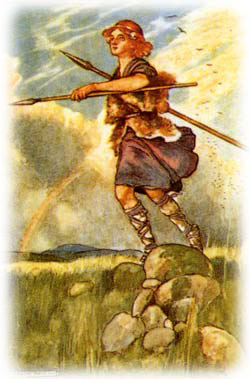

Cuchulain in some versions is said to be a foster child of Ulster, and in some respects his character is modeled on that of Lug of the historical-mythological cycle.

He is described as a small black-browed man, beardless and full of gaiety. When he is in battle a remarkable change comes over him; he increases in size, and his body trembles and whirls about inside of his skin so that his frontal features are turned to the rear. He can draw one of his eyes back into his head, and his hair bristles on end, with a drop of blood on the end of each hair. When he is in a warrior frenzy he attacks anyone in the vicinity, friend and foe alike.
The central story of the Ulster cycle is the Cattle-raid of Cuailnge (Tain Bo Cuailnge). Queen Medb of Connacht and her vanguard attempt to steal the great bull, Donn Cuailnge, owned by the men of Ulster. She desires this bull so that her possessions will equal those of her husband, King Ailill, who owns a great white-horned bull, Finnbennach. Through the structure of this story the exploits of Cuchulain and his companions, Conall Cernach and Loegaire Buadach, are related.
In the warfare against Queen Medb, Cuchulain realizes that he is fighting against supernatural forces that have been organized against him. Before the last battle, the Great Carnage of Murthemne, Cuchulain realizes the contradictory workings of his geasa. The geasa is a kind of personal obligation or taboo that cannot be violated by the individual without suffering dire consequences. For example, the sorcerers of Queen Medb are cooking a dog when Cuchulain
passes. One of his geasa obligates him to eat the food from any hearth that he passes; another of his geasa makes the meat of dog a forbidden food. When he eats the dog he feels some of his power leave him. In this manner he is depleted of his great powers and eventually is mortally wounded in battle.
SYMBOL OF SACRIFICE. Oliver Sheppard's bronze sculpture, 'The Death of Cuchulain' shows the hero tied to a stone pillar so that he may die on his feet, defending Ulster against overwhelming numbers. The figure now stands in the General Post Office, Dublin, where it symbolizes the sacrifices made during the Easter Rising of 1916, when the GPO served as the rebel headquarters.
THE DEATH OF A FRIEND. When Cuchulain's sworn friend Ferdia took service with Queen Maeve, the two were forced to fight. Cuchulain, the victor, carries Ferdia across the river so that he may lie with his own kind.